#emperor licinius of rome
Explore tagged Tumblr posts
Text
'I am no king, but Caesar'

Gaius Julius Caesar was born on July 12, 100 BC in the Suburra, a populous neighborhood of Rome, to a patrician family although in economic decline. In Gens Iulia, those who had the surname Caesar descended, according to the account of Pliny the Elder, from a man who was born after a Caesarean section (from the Latin verb "to cut", caedo, -ĕre, caesus sum). He was born in a Republic in crisis and the aristocracy divided into two warring factions: The optimates and populares. He lost his father when he was about 14 years old; he was greatly influenced by his maternal uncle Gaius Marius. Caesar had an older sister, Julia Major, and a younger sister Julia Minor (maternal grandmother of Emperor Augustus). His uncle, Gaius Marius, was the leader of the Populares ("supporters of the people") and rival of Lucius Cornelius Sulla, leader of the Optimates ( "best ones")

In 84 BC Lucius Cornelius Cinna, an ally of Gaius Marius, chose the 16 year old Caesar to be flamen Dialis (priest of Jupiter) and married him to his 13 year old daughter Cornelia with whom Caesar had a daughter named Julia. It is not certain whether the girl was born a few months before or after the teen Caesar had fled Rome or, more likely according to historians, she was born when he returned years later and was reunited with his wife who died giving birth to Julia.
Following the suicide of Gaius Marius in 86 BC, Cinna, one of the leaders of the Populares, became sole ruler of Rome and most of the provinces while persecuting Sulla's followers. In 84 Cinna was assassinated and populares defeated. Because of Caesar's alliance with Cinna's family he was targeted for revenge by the dictator Sulla who attempted to force him to repudiate Cornelia, but Caesar refused and fled Rome to the East.

In addition to being a politician and a soldier, Julius Caesar was a writer. Among others, his works were a treatise on astronomy, another on Roman religion, a study on Latin and his comments on the war in Gaul and the Civil War; only his writings on those two wars have not been lost.
After Sulla's death from natural causes, Caesar decided to return to Rome. He was reunited with his wife Cornelia, who had waited faithfully for him. After the death of Cornelia, he suffered a great mourning.

After serving as quaestor in the Hispania Ulterior province where he increased his network of clients - patronage was key to success in Roman politics - Caesar returned to Rome in 69 BC where he served as Aedile; he carried out building programs and offered the largest gladiatorial games seen until then. This left him almost bankrupt. In 60 BC he decided to make a private agreement with the prestigious general Pompey the Great and one of the richest man, Marcus Licinius Crassus. Pompey had just put an end to the pirate problem and years earlier, together with Crassus, he had defeated the slave rebellion led by Spartacus.
Pompey and Crassus were hampered in many of their ambitions by the Optimates in the Senate. Caesar, knowing this, approached them to put together an unofficial coalition - known to history as the Triumvirate - if they made him Consul, he would see to it that laws were passed that would benefit them. To further consolidate this alliance, Caesar married Pompey to his only daughter, Julia. Although this was a typical political marriage, classical sources state that Julia truly loved Pompey and he loved her.
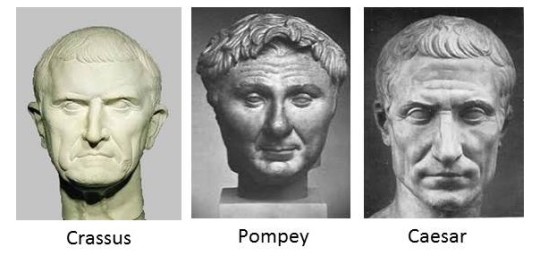
Pompey and Crassus decided to ally themselves with Caesar and the populares in order to gain more offices and wealth. In this way, the three took full control of Rome. In 59 Caesar was appointed consul.
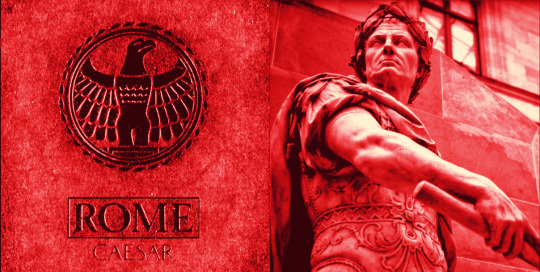
Laws were passed granting the province of Syria to Crassus. Laws were passed distributing lands among Pompey's veterans. And at his own request, the Gallic provinces-both the pacified and the "wild" ones- were handed over to Caesar. Cicero, a true defender of the Republic, was exiled due his bold speeches against the Triumvirate, which he called a "three-headed monster" but was allowed to return the following year. The passage of the laws favoring the triumvirs was ensured by introducing veteran legionaries of Pompey into the meetings of the Senate.
Also in 59 BC Caesar established a military camp in the Arno valley, on the Via Cassi, the main communication route between Rome and the north of the country. He called the camp Florentia, which means "flowering." The camp quickly became an important commercial town. Today it is the beautiful Italian city Florence.

In Gaul with his legions, he defeated and subdued several peoples in just a few years. Caesar wrote in detail about this conquest in his Bellum Gallicum (Gallic War). Believing that everything was under control, he headed to the mysterious land that the Romans called Britannia and where they believed the world ended. The Gallic War was between 58-52 BC

Caesar finally arrived in Britain for the first time in the summer of 55 landing with two legions. The following year he arrived with 800 ships, five legions and 2,000 cavalry. Caesar's comments on this war constitute the first written descriptions of the people, culture and geography of the island.

Although Caesar not conquered Britania (it was conquered under the Emperor Claudius) this campaign it established Rome's first allied peoples in Britain.
While in Britania, Caesar received the news that his daughter and the baby she was expecting had died in childbirth.
At the same time he had no idea that a genuine leader named Vercingetorix, chief of the Arverni tribe, had managed to unite all the Gallic peoples under his authority, determined to expel the Romans
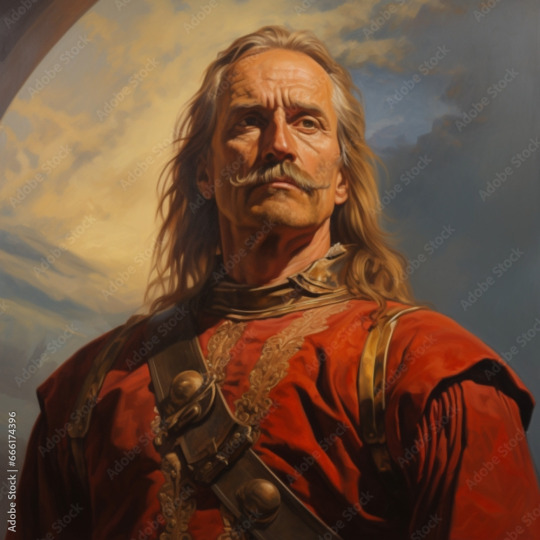
Caesar himself called him "King of all Gauls"
The most famous and final battle was that of Alesia. Although Vercingetorix was a great warrior, he could do nothing against the genius (sometimes bordering on madness) of Caesar and his legionaries. According to Caesar, Vercingetorix, seeing that if he continued he would starve his entire people to death due to the siege, rode towards the Roman camp, dismounted, took off his sword and sat on the ground without saying a word. He decided to surrender in exchange for his people living. And so it happened, Vercingetorix was taken prisoner but his men were not executed. But Caesar had to wait years for his triumph -and Vercingetorix had to wait as a prisoner in Rome, before his execution- because while Caesar was fighting against the Gauls, many Roman senators were plotting his downfall.

Everything Caesar wrote about his battles and conquests, written in the third person, was copied and sent to be read publicly in Rome, which was celebrated by the plebs and Caesar 's supporters. True republicans such as Cato, Cicero, Cassius, and Brutus perceived a real danger to the Republic. The Triumvir Crassus was killed by Parthians in his failed attempt to conquer Parthia: The triumvirate was over and Pompey, who had become Sole Consul saw in Caesar a dangerous rival, and allied himself with the Optimates again.
They created a new law that prohibited running for public office in absentia. Thus, Caesar, who was away from Rome, lost the protection of the law that granted him a magistracy and could not run for consulship in order to return to Rome as consul. If he returned as a private citizen he would be lost everything. So in January 49 BC he decided returned to Rome with the force of his legionaries who followed him with devotion.
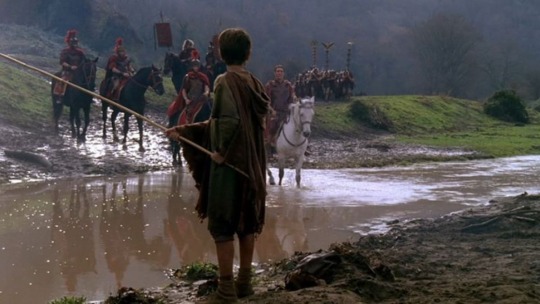
No legion could cross the Rubicon River, that meant civil war. Caesar crossed the Rubicon with his XIII legion and proclaimed a very popular phrase in Ancient Rome that players always said before throwing the dice: "Alea Iacta Est" (the die is cast). This is known thanks to Roman historians who took as a source the writings of Gaius Asinius Pollio, who was close to Caesar and could have heard him.
Pompey and his legionaries left Rome and prepared for the war in Greece. In September of 48 Pompey was defeated at the Battle of Pharsalus. But he did not give up and headed to Egypt to seek the support of the young king Ptolemy XIII. Egypt was then a vassal kingdom of Rome due to its years of indebtedness, and the creditor was precisely Pompey, who had lent huge sums to Ptolemy XII. But as soon as he landed in Egypt, he was met by a group of men who, in the name of the young king, beheaded him and took his ring.
While Cato the Younger and his men went to the province of Africa to continue the resistance, and Pompey's sons did the same in Hispania. Caesar went looking for Pompey to try to come to an agreement.
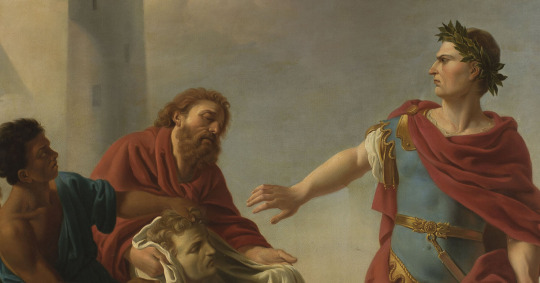
'Julius Caesar’s Dismay Upon Seeing The Head Of Pompey' (detail) By Louis-Jean-François Lagrenée (18th century)
King Ptolemy XIII, who was engaged in his own war with his sister Cleopatra for the throne, thought that by killing Pompey and giving his head and ring as a gift he would earn Caesar's gratitude and thus his kingdom would settle the unpayable debt it owed Rome. But Caesar was enraged by the undignified manner in which a Roman general and consul had been murdered and decided to side with Cleopatra and her allies.
The meeting between Cleopatra VII and Caesar at night and she entered hidden inside a huge rolled-up carpet carried by his slaves. Cleopatra was one of the many lovers that he had, they lived together and had a son, nicknamed Caesarion (little Caesar) whom he recognized but not legally. While some Republican Roman forces continued to resist, Caesar was immersed in the war between Ptolemy XIII, Cleopatra and the other sister, Arsinoe IV. Caesar's troops, together with those of Cleopatra plus Caesar's allies such as Mithridates of Pergamon and his army and a Jewish armed force led by Antipater finally won that war in January 47 and Cleopatra kept the throne of Egypt.
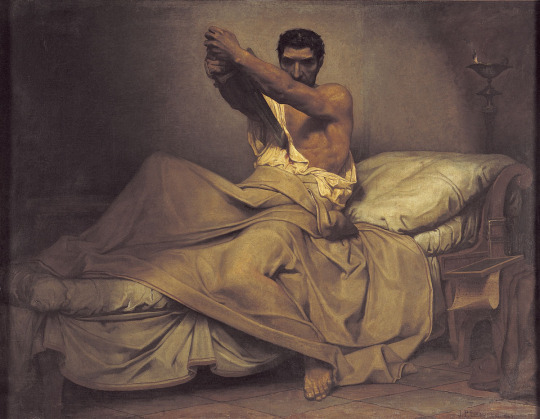
'The Death of Cato of Utica' , By Jean-Paul Laurens.
In early 46 BC, Caesar defeated the army of Cato the Younger . The 49-year-old Cato did not take part in the battle and being in Utica, Africa, after receiving the news that Caesar had won and pardoned his adversaries, decided to take his own life for refusing to "live a life spared by a tyrant." Cato had a republican soul but was stubborn man, and was convinced that Caesar wanted to be king. He was the half-brother of Brutus's mother, Servilla (Caesar's long-time lover)
It was in this same year that Caesar, with the advice of the astronomer Sosigenes of Alexandria, reformed the calendar, leaving each month with the same number of days as it has today and creating the leap year.
The final battle of Munda, in Hispania, was on March 17, 45 BC, thus ending the civil war. Caesar returned to Rome and an intimidated Senate legitimized his victory by appointing him dictator for a ten-year term.
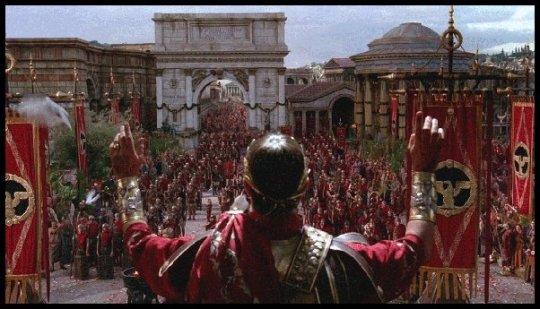
The position of Dictator was created by the Republic itself; he was a magistrate, elected by the Senate, with absolute powers to resolve military emergencies or exceptional tasks for a period of six months. He had to leave after that period or before if he managed to resolve the problem. This 10-year dictatorship was unprecedented.
In February 44 BC, Caesar succeeded in having the people of Rome proclaim him dictator for life. Cicero resigned from political life in protest.
Cassius persuaded Brutus that the only way to save the Republic was to kill Caesar. They needed Brutus to lead the conspiracy because of his prestige; he was not only Cato's nephew but also the direct descendant of the Republic's founding father.
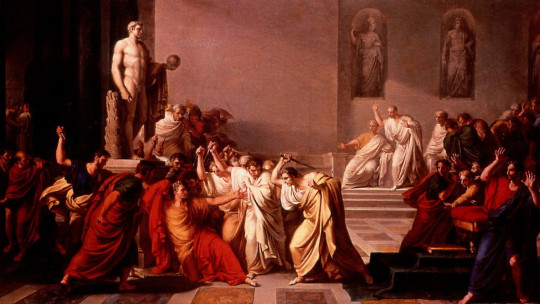
On 15 March 44 BC the group of conspirators intercepted Caesar just as he was passing the Theatre of Pompey, where the Roman Curia was meeting, and led him into a room off the portico. Lucius Tillius Cimber, under the pretext of presenting a petition, grabbed Caesar's toga with both hands and pulled him so tha Publius Servilius Casca could stab him, causing Caesar to exclaim "Ista quidem vis est?" "What kind of violence is this?" (Caesar, being Pontifex Maximus, was legally untouchable). Senator Casca, drawing a dagger, slashed him across the neck. "What are you doing, Casca, you villain?" were perhaps his last words. According to classical sources, he tried to flee but slipped on his own blood, fell to the ground and was stabbed. A Roman coroner stated that "Caesar's body had 23 dagger wounds but only one of them, in the chest, was fatal." They also claim that Caesar fell at the feet of the marble bust of Pompey the Great and as he lay dying he took his toga and covered his face so that no one would see him die. He was 55 years old.

Mark Antony with other colleagues carefully collected the body and carried it before the people. Then he made a memorable speech.
The month then called Quintilis, the month of Caesar's birth, was renamed Iulius (July) in his honour on the initiative of Mark Antony. Julius Caesar was the last dictator of Rome; the office was abolished after his death.
Caesar named his grandnephew Gaius Octavius Thurinus as sole heir and adopted son thus taking the same name as Gaius Julius Caesar. To differentiate them, historians refer to him as Octavius (or Octavian). But nowhere in his will did he say that his nephew should be his successor in office. It was very common in Roman aristocratic men who had no male children, adopted a nephew, the son of a sister or niece, or the grandson they had through a daughter, so that he could carry on his family name.
Octavius (Augustus) became the first Emperor of Rome after being part of a triumvirate that, unlike the first, was official, after years of several civil wars, and thanks to his iron will, his extraordinary cunning and political skill.
After his death, Caesar was proclaimed Divus Iulius, or the Divine Julius. He was the first Roman ruler to be deified. Mark Antony was the first to serve as Flamen Divi Julii, priest of the Caesar cult.
The name CAESAR would become the Title of Imperial Power, even many centuries later translated into other languages, such as the German Kaiser or the Russian Tsar.

In front of the theatre, an altar was erected where the pyre was placed so that Julius Caesar's body could be cremated in great mourning. Part of this altar is still preserved in the ruins; more than two thousand years after the assassination, every 15th of March, people come to leave flowers there.
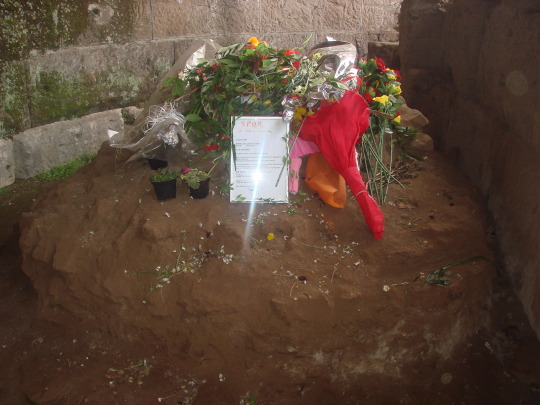
Photo by Giovanni Dall'Orto, taken on March 15, 2008 Attribution, via Wikimedia Commons
176 notes
·
View notes
Text

Marble portrait head of the Emperor Constantine I. Roman ca. 325–370 CE. x
Constantine the Great was the first Christian emperor of Rome, and his reign had a profound effect on the subsequent development of the Roman, later Byzantine, world. By 325 he had succeeded in reunifying the empire, having defeated the last of his former tetrarchic colleagues, the eastern emperor Licinius. He thereafter aimed to establish a new dynasty and to found a new capital, named Constantinople after himself. Christianity played an important role not only in Constantine’s personal life and success, but also in the program of reform and renewal that he had planned for the Roman Empire. Although the court and administration no longer resided at Rome, Constantine was careful not to neglect the old imperial city and adorned it with many new secular and Christian buildings. The most famous of these is the triumphal arch, the Arch of Constantine, which still stands near the Colosseum. Similarly, the fragments of a colossal statue that now adorn the courtyard of the Museo del Palazzo dei Conservatori in Rome, probably once stood in imposing grandeur in the main hall of the Basilica of Maxentius, a building that was completed by Constantine. Both of these works contain re-used material from earlier monuments, a practice that was not only economical but probably was also intended to shed reflected glory of the emperor by associating his reign in a very direct and practical way with that of famous “good” emperors from the past. The long face, neatly arranged hairstyle, and the clean-shaven appearance of this portrait head are a deliberate attempt to evoke memories of earlier rulers such as Trajan, who in the later third and fourth centuries was seen as an ideal example of a Roman emperor. Certainly, by the time that the head was set up, as part of either a bust or, more probably, an over life-sized statue, Constantine had adopted an official image that was intended to set him apart from his immediate predecessors.
20 notes
·
View notes
Text
Greek Myth / Roman History Chickens master post
Iliad chickens 1:
Iliad chickens 2:
Cassandra / Cassand-BAWK:
Roman History Chickens:
Late Republic
Augustus, Marc Antony and Cleopatra chickens :
First Triumvirate chickens:
Julio Claw-dians:
The succession of Augustus (with Livia and Tiberius)
56 notes
·
View notes
Text
CONSTANTINE THE GREAT
CONSTANTINE THE GREAT
c.272 - 22 May 337 CE
ROMAN EMPEROR WHO CONVERTED TO CHRISTIANITY
Constantine was born in Naissus, Moesia (Serbia) and campaigned against the Persians and was with his father in Britannia. Constantine was declared Emperor of Rome by his father’s soldiers in York, England after his father died in 306. Constantine had to deal with civil wars, and had to overcome rivals such as the Eastern Emperor Licinius who he eventually defeated.
Constantine became Christian in 312 and was the first Christian Empeor of Rome. He allowed freedom through the empire, which put the end of persection for Christians. He was also the one who established the unity of church and state. He had the Church of the Holy Sepulchre built in Jerusalem on the apparent site of Jesus’ tomb.
Constantine became ill and knew he was near death and had a final resting-place prepared for himself and spent his last days praying. He died aged 65. Constantine was buried in the Church of the Holy Apostles, his tomb and body was destroyed not long after the Fourth Crusade in 1204.
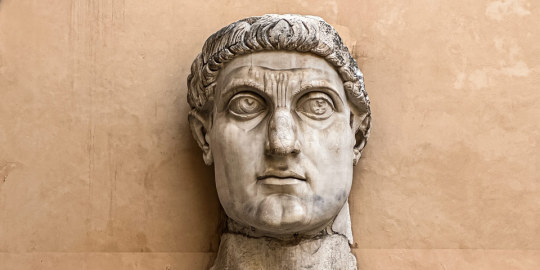
#constantine #constantinethegreat #ancientrome
3 notes
·
View notes
Text
top 5 roman deaths that could have changed the world
5. quintus fabius maximus verrucosus
hannibal is rampaging across italy, destroying every army the romans raise against him in humiliating defeats. fabian becomes dictator and proceeds to do... nothing. but it works and just keeping a roman army in the field without leading them all to their deaths is important. other commanders adopt his strategy of not engaging unless victory is certain. probably he's why rome survives the second punic war and eventually is able to go on to win it. what if instead he had been assassinated for his 'cowardice' or 'treason' in refusing to confront hannibal head on. what if instead the roman empire had died in the cradle and the carthaginian empire had been born, having conquered its greatest rival.
4. marcus licinius crassus
imagine the dude kicks the bucket on the eve of his debacle in parthia. instead of leading these men and his son to their deaths in the desert sands, the army is mustered and ready to march off but he dies and his son takes over instead. would he have made the same disastrous mistakes as his father or would he have returned to rome a conquering hero greater than gaius julius?
3. constantine the great
diocletian had all his ducks in a row with the previous emperors retiring and their caesars rising to the rank of co-augusti. but constantine (and others who felt their right to inherit the empire was being unduly ignored, but constantine was most successful) is here to fuck all that up. suppose instead he gets trounced at the milvian bridge and even dies or is captured (and then executed). maybe diocletian's succession sticks and becomes a precedent where every 10 years the augusti step down and their caesars step up. and more importantly, maybe the empire never becomes christian.
2. irene of athens
what if instead of blinding her own son and damning her line she had instead kicked the bucket and let the seemingly capable emperor take full control? this period is so wild and so scant for sources that it's even harder to imagine how this counterfactual might play out than any of the others but certainly blinding and killing your only heir isn't a strong play.
antoninus pius
he was supposed to keep the seat warm after hadrian died until marcus aurelis could take over as a capable and long-reigning man. but the 54-year-old kept on kicking for another 23 years, keeping marcus bottled up in the capital with him. even assuming shit still hits the fan upon his death and rome is attacked by those who had been peaceful under the capable emperors hadrian and antoninus pius, rome might have been better able to fend it off a decade earlier. because a decade later a plague was making fighting a war and keeping the army supplied and manned a debilitating task, especially for a man who spend 23 years essentially bookkeeping alongside the emperor.
#ancient rome#roman empire#byzantine empire#what if#counterfactual#pretty light on the byzantines#but these are the what ifs I personally wonder the most about
7 notes
·
View notes
Text
Saints&Reading: Saturday, May 4, 2024
april 21_may 4
Holy and Great Saturday: Descend into Hades

MARTYR ALAXANDRA THE EMPRESS, WIFE OF DIOCLETIAN (303)

Diocletian's wife (284-305). Her supposed death iThe Holy Empress Alexandra was Diocletian's wife (284-305). Her supposed death is described in the Martyrdom of Saint George, written immediately after his death. The empress, however, received the crown of martyrdom several years later, in 314.
Many events occurred during these years. In 305 the emperor Diocletian resigned the throne and power passed to his co-ruler Maximian Galerius (305-311), a fanatic pagan, as well as a coarse and fierce soldier. His wife was Saint Valeria, the daughter of the holy Empress Alexandra, whom Diocletian had given in marriage against her will.
Saint Alexandra raised her daughter in Christian piety. When Galerius died, the emperor Maximinus sought her hand in marriage. When he was refused, he banished Saint Valeria to Syria, where she lived with her mother.
After the death of Maximinus in 311 the mother and daughter arrived in Nicomedia, trusting in the mercy of the emperor Licinius (311-324). Together with Saint Constantine, he had subscribed to the Edict of Milan, which gave Christians the freedom of religion, but secretly he remained an enemy of Christianity. Licinius gave orders to execute the holy Empress Alexandra and her daughter Valeria. They were beheaded, and their bodies thrown into the sea.
SAINT MAXIMIAN, PATRIARCH OF CONSTANTINOPLE (434)
Saint Maximian (or Maximus) was born in Rome to wealthy and pious parents. He was a guileless man who preferred to live far from worldly vanity. He was also learned, intelligent, and was known for his many virtues, the integrity of his life, and his incomparable character. Because of his pure and holy life, Patriarch Sisinίos of Constantinople ordained him as a priest. At his own expense, Saint Maximian would pay for the burial of persons who were conspicuous for the holiness of their lives.
After the heresiarch Nestorios was deposed and exiled, Saint Maximian became Patriarch on October 25, 431, with the fervent support of both the reigning Emperor Theodosios the Younger (408-450), and the faithful people.
Saint Maximian reposed peacefully on April 21, 434 (Great and Holy Thursday).


ROMANS 6:3-11
3 Or do you not know that as many of us as were baptized into Christ Jesus were baptized into His death? 4 Therefore we were buried with Him through baptism into death, that just as Christ was raised from the dead by the glory of the Father, even so, we also should walk in newness of life. 5 For if we have been united together in the likeness of His death, certainly we also shall be in the likeness of His resurrection, 6 knowing this, that our old man was crucified with Him, that the body of sin might be done away with, that we should no longer be slaves of sin. 7 For he who has died has been freed from sin. 8 If we died with Christ, we believe that we shall also live with Him, 9 knowing that Christ, having been raised from the dead, dies no more. Death no longer has dominion over Him. 10 For the death that He died, He died to sin once for all; but the life that He lives, He lives to God. 11 Likewise you also, reckon yourselves to be dead indeed to sin, but alive to God in Christ Jesus our Lord.
MATTHEW 28:1-20
1 Now after the Sabbath, as the first day of the week began to dawn, Mary Magdalene and the other Mary came to see the tomb. 2 And behold, there was a great earthquake; for an angel of the Lord descended from heaven, and came and rolled back the stone from the door, and sat on it. 3 His countenance was like lightning, and his clothing as white as snow. 4 And the guards shook for fear of him, and became like dead men. 5 But the angel answered and said to the women, "Do not be afraid, for I know that you seek Jesus who was crucified. 6 He is not here; for He is risen, as He said. Come, see the place where the Lord lay. 7 And go quickly and tell His disciples that He is risen from the dead, and indeed He is going before you into Galilee; there you will see Him. Behold, I have told you. 8 So they went out quickly from the tomb with fear and great joy, and ran to bring His disciples word. 9 And as they went to tell His disciples, behold, Jesus met them, saying, "Rejoice!" So they came and held Him by the feet and worshiped Him. 10 Then Jesus said to them, "Do not be afraid. Go and tell My brethren to go to Galilee, and there they will see Me." 11 Now while they were going, behold, some of the guard came into the city and reported to the chief priests all the things that had happened. 12 When they had assembled with the elders and consulted together, they gave a large sum of money to the soldiers, 13 saying, "Tell them, 'His disciples came at night and stole Him away while we slept.' 14 And if this comes to the governor's ears, we will appease him and make you secure.
#orthodoxy#orthodoxchristianity#easternorthodoxchurch#originofchristianity#spirituality#holyscriptures#gospel#bible#wisdom#faith#Saints
3 notes
·
View notes
Text
Valerian: The Life and Reign of a Roman Emperor in Crisis
Early Life and Rise to Power Valerian’s early life is shrouded in mystery, with few details about his background available in the historical record. He was born around 193 AD, likely into a senatorial family of considerable standing. His full name, Publius Licinius Valerianus, suggests a connection to the Licinii family, one of Rome’s prominent aristocratic clans. His upbringing would have been…
0 notes
Text
How Constantinople, the“New Rome”, was dedicated to the Mother of God
On learning of the tyrannical measures taken by the Roman emperor Maximinus II Daza in the East against the Christians, Constantine raised a powerful army, guided by the sign of the victorious Cross, and, during a campaign against the barbarians in Pannonia (1), penetrated Licinius' territory (2) in 322.
After an initial defeat at Andrinople, the tyrant retreated to Byzantium, before being definitively defeated at the battle of Chrysopolis on September 18, 324. The victorious Constantine, in the name of Christ and Truth, set about offering the reunited Roman Empire to the King of kings, and, like a new Apostle, proclaimed faith in the one God and in His Son incarnate for our salvation to the farthest reaches of East and West, from Mesopotamia to Great Britain. In an edict proclaimed throughout the Empire, he declared that God alone was to be considered the cause of his victories, and that he had been chosen by Providence to place himself at the service of good and truth. He urged all his subjects to follow his example, but without coercing anyone.
To this new Christian empire, which was to last a thousand years, Constantine decided to give a new capital, and inspired by a divine sign, the pious emperor fixed his choice on the small city of Byzantium, which occupied a pivotal position between East and West. He himself marked the boundaries of the new city, and instructed the master builder, Euphrata, to spare no expense in endowing it with monuments and public thoroughfares surpassing all other cities in the world in glory and magnificence.
When the city was founded on November 8, 324, Byzantium was named Constantinople and New Rome, and was subsequently dedicated to the Mother of God. Work was carried out with great haste, and on August 11, 330, the twenty-fifth anniversary of the emperor's reign, the inauguration of the new capital was celebrated with great pomp.
Source: Adapted from www.orthodoxie.com
Pannonia is an ancient region of Central Europe, straddling present-day Austria, Hungary, Slovenia, Croatia, north-western Serbia and northern Bosnia-Herzegovina. Licinius was Roman emperor from 308 to 324. For most of his reign, he was the colleague and rival of Constantine I
Hail, Mary, full of grace, the Lord is with you; blessed are you among women, and blessed is the fruit of your womb, Jesus. Holy Mary, Mother of God, pray for us sinners now and at the hour of our death. Amen.
0 notes
Text

These reverse of Roman coins belong to different emperors, and in many cases, these reverse it were common revers with different emperors(Elagabalus, Gordian , nero, Titus, domitian, Aulus Gabinius or Marcus Licinius Crassus Lucius Verus, hadrian .. etc) . Because it issued in Decapolis area (syria, Lebanon, Palestine, Jordan ) were a group of ten Hellenistic cities on the eastern frontier of the Roman Empire in the Southern Levant in the first centuries BC and AD. They formed a group because of their language, culture, religion, location, and political status, with each functioning as an autonomous city-state dependent on Rome. #archaeology #history #ancient #art #Caesar #ancienthistory #archaeological #rome #italy #roman_empire #roma #heritage #roman_republic #archaeologylife #Orichalcum #Roman_mythology #Decapolis #medallion #romancoin #romanarcheology #romanancientcoins#aureus #denarius #dupondius #follis #antoninianus #sestertius #fils #alsadeekalsadouk #الصديق_الصدوق
0 notes
Text
SPQR- Mary Beard; Ch 7
7 From Empire to Emperors
Cicero versus Verres In 70 BC Cicero took on a high profile case against Gaius Verres, governor of Sicily. He was trying to get compensation for the systematic theft and depredations of the defendant in his official role. The notorious case ended with Verres' self-imposed exile to Marseille, having seen how badly he was losing the case. This was just one of the controversies about Roman rule overseas. The nature of Roman power and Roman's assumptions about their relationship to the world they now dominated had moved from an empire of obedience to an empire of annexation.
Gaius Gracchus had passed wide ranging legislation to root out corruption and abuses of the system, and it clearly showed that there were those in Rome who were concerned about the abuses. The senate's incompetence and greed in overseeing the provinces came up with Sallust asking hard questions about their incompetence in governing. The senate was seen as an old boys network not up to the challenge of the new realities.
One of the "new men" that so many saw as an answer, was Gaius Marius. Marius was sent to Africa to deal with some upstarts, but he enrolled anyone he could find in the army, rather than those from landed families. These new legions were promised land after their service. But where would that land come from? It turned the soldiers into loyal followers of their commanders, or whoever was promising them the best package, rather than loyal servants of Rome. But this change in attitude saw popular assemblies regularly voting vast resources to those they thought would best defend them, or expand the empire. They began to vote autocrats into power.
Pompey the Great In 66 BC, Cicero addressed the public pushing for Pompey to be given vast powers to subdue Mithradates. He pointed to Pompey's success the year prior clearing the pirates from Italy's waters. He was essentially arguing that new problems called for new solutions. As the empire had expanded, Rome's government had not kept up. It's style was still to limit power and control through checks and balances- which hindered officials from getting stuff done. What Rome needed now was the best general, with lengthy command, over the whole of the affected area, and with the resources needed to accomplish the job.
The first emperor Pompey could lay claim to being the first emperor. The honors he accepted and claimed were on a completely different and greater scale than before... at least in Rome. The only thing that stopped Pompey was a rival- Julius Caesar.
The Gang of Three In 60 BC, Pompey was frustrated the Senate was dragging his eastern settlement out. Marcus Licinius Crassus, the recently returned general who had defeated Spartacus, was annoyed his case was being slow-walked through. Julius Caesar was hoping to get elected consul and secure a lucrative military command. Mutual support seemed the best way for them to get what they wanted, so they teamed up to pool their resources. Caesar was elected and he pushed through programs of the other two. Crassus was defeated and lost his life fighting the Parthians in modern Iran.
But there were increasing breakdowns in public life, with more political violence occurring. In 52 BC, Pompey was elected sole consul. He was also granted the power to settle the uncertainty in the streets, which he did within a few months.
In 58 BC, Caesar had left for a military campaign in Gaul. He had military ambitions beyond what had been seen to date, and he conquered more land for Rome than Pompey had in the east. It was a particularly brutal and bloodthirsty campaign and shocked even Roman sensibilities. Some suggested he even be prosecuted back home. There was also a question of what he would do with the power and wealth he accumulated while in Gaul. Caesar was in charge of 40,000 troops. Would he invade Italy as Sulla and Pompey had done?
IN 50 BC, the Senate voted in an overwhelming majority that both Pompey and Caesar should give up their posts and Caesar should return home. He crossed the Rubicon in 49 BC and 4 years of civil war ensued. Between battles fought in Africa and Spain, Caesar was rarely in Rome. He fought against Pompey, his old ally, but now rival, for control of Italy. Pompey was eventually beheaded as he tried to land ashore by a local leader who thought he could earn some points with Caesar. It backfired and Caesar supported the leader's rival- Queen Cleopatra. Cleopatra's interests were with Caesar at this point and they had an open affair, and, if Cleopatra is to be believed, a son.
The Ides of March Julius Caesar was killed on 15 March 44 BC. This has been framed as the template of principled assassination in order to preserve liberty ever since. But looking back, it was just the latest in a series of murders of powerful politicians. Julius Caesar had initiated a vast series of reforms. He updated the Calendar. He launched a large number of overseas colonies to resettle Rome's poor elsewhere. He extended Roman citizenship to the north of Italy, and at least Latin status to Sicily. He instituted vast reforms in Roman government. These reforms became a takeover of Rome's democratic processes, and it smacked of him trying to become king. He seemed to not be taking the elected offices of the Roman republic seriously. Even his most famous virtue, mercy, was the virtue of a king. Only those with the power to do otherwise can exercise mercy.
So the assassins saw themselves as guarding liberty and Republican values. They told everyone the Roman people had been liberated. But getting rid of a tyrant turned out not to be the same thing as getting rid of tyranny.
0 notes
Text

SAINTS FOR MARCH 10
ST. JOHN OGILVIE, JESUIT AND MARTYR. Born in 1569, John Ogilvie belonged to Scottish nobility. Raised a Calvinist, he was educated on the continent. Exposed to the religious controversies of his day and impressed with the faith of the martyrs, he decided to become a Catholic. In 1596, at age seventeen he was received into the Church at Louvain. Later John attended a variety of Catholic educational institutions, and eventually he sought admission into the Jesuits. He was ordained at Paris in 1610 and asked to be sent to Scotland, hoping some Catholic nobles there would aid him given his lineage. Finding none, he went to London, then back to Paris, and finally returned to Scotland. John's work was quite successful in bring back many people to the Faith. Some time later he was betrayed by one posing as a Catholic. After his arrest he was tortured in prison in an effort to get him to reveal the names of other Catholics, but he refused. After three trials, John was convicted of high treason because he converted Protestants to the Catholic Faith as well as denied the king's spiritual jurisdiction by upholding the Pope's spiritual primacy and condemning the oaths of supremacy and allegiance. Sentenced to death, the courageous priest was hanged at Glasgow in 1615 at the age of thirty-six
St. Attalas, 627 A.D. Abbot and companion of St. Columban. Born in Burgundy, France, he studied under Bishop Aregius of Gap. He became a monk at Lérins but then went to Luxeuil, where St. Columban taught him a strict rule of religious life. Attalas served as Columbian’s companion when the Irish saint went to Bobbio, in Italy, and founded a monastery there on lands donated by King Agilulf of the Lombards. In 615 St. Columban died, and Attalas succeeded him as abbot. Attalas was a foe of the heretical Arians. lie was also noted for performing miracles. His tomb is in Bobbio, beside the shrine of St. Columban.
St. Sedna, 570 A.D. Bishop of Ossory, in Ireland. Sedna was also the abbot of Seir-Kieran Abbey, founded by St. Kieran with the aid of St. Patrick’s miraculous bell. Ossory was governed by abbot-bishops until circa 1184.
St. Emilian, 675 A.D. Irish-born abbot of Lagny, France, also called Eminian or Imelin.
St. Himelin, 750 A.D. Irish or Scottish priest who went on a pilgrimage to Rome. A maid of the parish of Vissemaeken, Belgium, gave him water from a pitcher and it turned to wine. He died at Vissemaeken, where he is venerated.
St. Kessag, 560 A.D. Prince of Cashel, Ireland, and bishop of Scotland. Sometimes called Mackessag. Kessag went to Scotland as a missionary bishop, using Monk’s Island in Loch Lomond as his center. He was martyred at Bantry or at some unknown site. Kessag is credited with some extraordinary miracles. He is patron of Lennox, England.
ST. SIMPLICIUS, POPE
Martyrs (Forty) of Armenia, Roman Catholic soldiers martyred by Emperor Licinius Licinianus at Sebaste, in modern Armenia. They are also called the Martyrs of Sebaste. The martyrs were forced to march naked upon the ice of a frozen lake after they refused to abjure the faith. Feastday March 10
0 notes
Text
Vandal Savage
“I am not a caveman. I am a visionary. A veteran and orchestrator of every significant war mankind has ever had. And I will continue to shape the world for the war of tomorrow. My tomorrow.” - Vandal Savage

Real Name: Vandar Adg II
Aliases:
Cain
Blackbeard
Emperor Licinius of Rome
Mister Dekker
Gender: Male
Height: 5′ 10″
Weight: 176 lbs (80 kg)
Eyes: Brown
Hair: Black
Powers:
Unique Physiology
Dimensional Travel
Abilities:
Genius Level Intellect
Leadership
Martial Arts
Seamanship
Swordsmanship
Tactical Analysis
Weaponry
Firearms
Multilingualism
Equestrianism
Weaknesses:
Blood Sacrifice
Universe:
Earth-Two
New Earth
Parents: Vandar Adg; father
Marital Status: Single
First Appearance: Green Lantern #10 (December, 1943)
Last Appearance: Action Comics #900 (June, 2011)

Powers
Unique Physiology
Immortality
Enhanced Intellect
Superhuman Durability
Superhuman Strength
Superhuman Speed
Dimensional Travel

Abilities
Genius Level Intellect
Leadership
Martial Arts
Seamanship
Swordsmanship
Tactical Analysis
Weaponry
Firearms
Multilingualism: He knows English, Egyptian, Frankish, French, Greek, Russian, German, Latin, Spanish, Romanian, Atlantean, and possibly various others.
Equestrianism

Weaknesses
Blood Sacrifice: Savage renews these powers through the consumption of his enemies' blood. Savage must also harvest the organs of his blood descendants to sustain his immortal life.

Origins
Vandar Adg was a caveman and leader of the Blood Tribe who was born 50,000 years ago. When he was a teenager, a mysterious man killed his father, who was named Vandar Adg. When Adg grew to the manhood, a mysterious meteor crashed to the ground, bathing him in radiation, and granting him incredible intellect and immortality. An observer from the Bear Tribe would later approach that same meteorite and become Savage's eternal nemesis, the Immortal Man, possessing the power to resurrect as a new persona every time he is killed.
He took the name Vandal Savage but he was banned from the Blood Tribe after losing a fight to Bruce Wayne, who was lost in time. His first mark on history came when he and a select group of people successfully undermined and destroyed the lost city of Atlantis. That group of people became known as the Illuminati, with Savage serving as its leader, then and ever since.
In 2578 BC, Nabu, a Lord of Order, created the Scarab with the help of a time traveler from the 20th Century. This was an attempt to overthrow Savage, who was at that time the pharaoh called Khafre; an impostor instead was killed in his place.
Around 1000 AD, a prophecy by a soothsayer told him he one day meet "The Hanged Man" who will meddle with the pair of Black Lantern he discovered. He decided to create the city of Sapristi in Bohemia along with a fortress to trap to "Hanged Man."
In 1358 AD, Savage returned on hunt for the hanged man. Every time he returned he used the spheres in his possession to emit an emotional aura which pleasantly enrages him, and causes the city of Sapristi to erupt into rage and chaos. He toured the city over the centuries in hunt for his future rival.
In 1718 AD, Savage adopted the name of Edward Thatch, also known as the pirate Blackbeard and became a prominent figure in the criminal world. Using this name, Savage started looking for the treasure of the Miagani and defeated "The Black Pirate" in his quest. However, he came across Bruce Wayne once again and Savage was tricked after reaching the mysterious cave. After losing most of his crew, Savage was forced to retreat from Gotham and months later, rumors about Blackbeard's death began to spread across the land. However, the man who was killed was one of Savage's own crew. Savage survived and let everyone believe that Blackbeard was dead.
Once again in the 19th century, Savage adopted a new identity under the name of Monsieur Savage. He settled in Gotham City after he stole gold from Napoleon Bonaparte and learned of a secret box that held the secret to eternal life. As he had been diagnosed with a cancer, he sought the box to extend his already long-lived existence with help from bounty hunter Jonah Hex and a man called Thomas Wayne. However, his efforts were once again thwarted by Bruce Wayne, who retrieved the box from him and left him unconscious after another confrontation.
Over the centuries, Savage's name appeared over and over again in Western history, as adviser to kings and pharaohs in Sumer, Egypt, and Europe. He claimed to have ruled hundreds of civilizations under hundreds of names: Khafre, Alexander the Great, Julius Caesar, Genghis Khan, and Vlad the Impaler, to name a few. He had also worked as close friends and advisers to the likes of Erik the Red, Napoleon Bonaparte, Ra's al Ghul, Otto von Bismarck and Adolf Hitler. He was the court physician in France, and even used the royal family for syphilis experiments.

Modern Age
Beginning in the 1940s, Savage frequently battled the Justice Society of America. One attempt to capture the members of the Justice Society out of revenge was thwarted by two Flashes, Jay Garrick and Barry Allen.
Ultimately, Savage's enemy, the Immortal Man, erased himself from existence to save the world during the Crisis on Infinite Earths, and Mitch Shelley, the Resurrection Man, an amnesiac with similar powers, took over as Savage's nemesis. However, Savage's list of foes is not limited to those two individuals. Having lived so long, Savage has butted heads with possibly every single hero in past, present, and future, most notably the Justice Society of America and the Justice League of America. At present, Savage is about 52,000 years old.
Over time, Savage forgot many of his special powers, and never exhibited them to Barry Allen. However, he later began a quest to recharge them by killing. His first intended victim was Wally West, who by then had taken over the mantle of the Flash. During this time, he operated the Villers Gallery, an antique salon on Fifth Avenue in New York City. A private investigator by the name of Harold Halston from Thermopolis, Wyoming had been investigating one Varney Sack at the request of a local realtor. Sack turned out to be Savage, and the immortal man killed Halston once he figured the the private eye knew too much. In a showdown at the Club Neon, Wally, with the help of Frances Kane, fought Savage. He fell out of a window, but he disappeared before he hit the ground.
Savage surfaced again later, this time selling Velocity 9, a highly addictive super-speed drug of his own creation, which interfered with much of the existing drug trade in New York. He put an ad in the paper that attracted successful yuppies, who he used to do his bidding by giving them Velocity 9 so they could perform high speed crimes. However, these junkies aged at magnificent rates and suffered strokes easily.
Savage wished to use the heroin distribution network headed by mob boss Nick Bassaglia to distribute Velocity 9 to lawyers and stockbrokers, hoping to gain financial control of New York. However, Flash, who had gone looking for Bassaglia after he was kidnapped by Savage, was injected with Velocity 9. After giving him a short spurt of incredible speed, it took away his powers. Hoping that a second dose would make him another one of his junkies, Savage told Dr. Conrad Bortz to inject the Flash, who instead injected Savage, who ran away.
He reappeared later, wanting money to leave the country. This money he attempted to acquire by kidnapping Rosie, the daughter of Wally's landlord, Mr. Gilchrist, with a ransom of five million dollars. He set many traps for the Flash, who was looking for Rosie, which led him to Barry Allen's grave, where Rosie was being kept. However, throughout all of this, Savage never showed his face.
Originally Savage was a member of Alexander Luthor's Secret Society of Super-Villains, but he quit and told Lex not to contact him for any reason. This was likely because his daughter Scandal was working against the Society as part of the Secret Six. When the Society lodged a final ambush against the Six, Vandal threatened to kill Luthor if he did not call off the attack, saying that he could not allow anyone to harm his daughter. Whether this was a case of fatherly concern or Vandal has ulterior motives for his daughter remains to be seen.

One Year Later
During the wake of the Infinite Crisis, Savage took a drastic turn his own ways on taking over the world in which he decided to restart human civilization by destroying Earth by pulling an asteroid into the planet. While leading a doomsday cult to help his plan accomplish, Savage's plot was foiled by the Flash and the asteroid was sent back into space, along with Savage. Eventually the asteroid fell back to Earth with Savage, who then discovered his immortality was declining and would therefore lead to his own demise. Savage chose to preserve his life by stealing the DNA of Green Lantern Alan Scott. Using a deformed clone of the original Sandman, Wesley Dodds, Vandal Savage's plans of capturing Scott failed. However, Savage found himself surviving by inhumane means when consuming a clone of himself, preserving his life a year longer.
Savage would later form a group of super-powered Neo-Nazis called the Fourth Reich to murder the heirs of several Golden Age superhero bloodlines, in the belief that eliminating the bloodlines will eliminate the heroes' legacies and allow him to continue his goal of reshaping the world according to his own desires. His victims include Minute-Man, Mister America, and General Glory, along with their families. Savage took the liberty of personally eliminating Wildcat and his son Tom Bronson himself, but only to be underestimated by Bronson's transformation into a cat-like creature who was able to overcome Savage. Ultimately, Savage's slaughter ended with his temporary defeat by Wildcat and his son, and the Fourth Reich defeated by the Justice Society.

Salvation Run
Savage was captured by American government authorities and was among of many villains that were secretly deported to the hell planet called "Salvation," which unknown to the deportees and their handlers that the planet was a training ground for the Parademons of Apokolips. Surviving the planet's deadly flora and fauna, Savage used his knowledge to locate a "safe zone" freed from any predators. He lead a group of all-female villains to this safe zone with intentions of mating them and to build his own civilization. However, the women turned against him once they learned that he had been manipulating them to turn against each other. Ultimately, Savage escaped back to Earth along with the villains following an attack by Parademons sent by Desaad.

Final Crisis
After returning to Earth, Savage became a member of the Society's second incarnation underneath Libra, serving as one of his inner cabinet members, during the Final Crisis. He also became involved with the Religion of Crime and was revealed to be actually the man the Religion of Crime worships as "Cain", the original murderer and sinner. Savage was reborn as Cain after cultists of the Religion of Crime plunged the Spear of Destiny into him. As Cain, he went on a path of revenge against the Spectre for punishing Cain in the past.
Managing to defeat the Spectre, Cain used the Spear of Destiny to separate the Spirit of Vengeance from his human host, Crispus Allen, and made him his slave. Though he almost has his revenge Cain's plan went undone by The Question, who managed to steal the Spear and reunite the Spectre with Crispus Allen. The Spectre spared from killing Cain as forbidden by God and instead had him branded by the Mark of Cain, being forever reviled and persecuted by the world until God feels that this punishment was justified.
Savage walked the Earth after his devastating defeat before coming across and assisting his colleague Ra's al Ghul and the Outsiders on defeating Savage's former tribesmen called the Insiders, who were exposed to the same meteor that granted Savage immortality. Savage would later on encounter the Huntress and The Question, managing through threats against the both of their lives to get The Question to take the Mark of Cain from him and carry it herself.

Fun Facts
Savage will possibly meet his end in the year 85,271 A.D., when he is sent back in time to 20th century Montevideo, Uruguay, seconds before it is decimated by a nuclear weapon, an action that was, ironically, ordered by Savage himself. This is, however, only one possible future for Savage.
Archaeological evidence has suggested that Vandal Savage is actually the inventor of Cannibalism.
Vandal Savage has been alive for centuries. As such he has influenced a few notable people in history, he was influenced by a few others and he actually was a few people in history. These people include Licinius, Varney Sack, Burt Villers, Khafre, Alexander the Great, Julius Caesar, Genghis Khan, Vlad the Impaler and Jack the Ripper.
According to Savage, 34,000 years ago he invented the carving knife, 3,200 years ago he fought alongside Moses to lead the Isrealites out of Egypt from the Pharoah's rule, and 1,600 years he survived the destruction of the library of Alexandria.
#vandal savage#vandar adg ii#vandar adg#vandar adg 2#cain#blackbeard#emperor licinius of rome#emperor licinius#mister dekker#religion of crime#fourth reich#illuminati#injustice society#tartarus#blood tribe#the society#dc#DC comics#thedcdunce
10 notes
·
View notes
Photo

Denarius of the Roman emperor Augustus (r. 27 BCE-14 CE), commemorating the return of the legionary standards lost in the Parthian victory over M. Licinius Crassus at Carrhae (53 BCE). On the obverse, the crowned head of the goddess Feronia; on the reverse, a kneeling Parthian hands over one of the standards. Photo credit: Classical Numismatic Group, Inc. http://www.cngcoins.com
#classics#tagamemnon#Ancient Rome#Roman Empire#ancient history#Augustus#Emperor Augustus#Parthia#Parthian Empire#M. Licinius Crassus#Carrhae#Battle of Carrhae#art#art history#ancient art#Roman art#coins#ancient coins#Roman coins#ancient numismatics#Roman religion#religio Romana#Feronia
80 notes
·
View notes
Text
On this Day | 19 December
In 324 CE, Licinius abdicated his position as Roman Emperor. He had reigned for a period of 16 years from 308 CE, and was succeeded by his rival, Constantine I.

AV Solidus of Licinius struck at the Nicomedia mint between 317 and 318 CE.
#classics#tagamemnon#on this day#onthisday#licinius#roman empire#rome#italy#ancient rome#ancient italy#roman history#roman emperor#emperor#ancient history#history#december#19 december#solidus
20 notes
·
View notes
Note
Hey Tech, why does Gregor say "plebe" all the time?
*adjusts goggles* While I cannot opine upon the colloquial uses of the term "plebe" in modern vernacular, the etymological source of the word originates from "plebeian." The plebeian class in Ancient Roman society referred to the "common people," who were a distinct group from the "proletariat" or working class, and the "patrician" or ruling class. Plebians and patricians were families who were respectively not traceable and traceable back to the beginning of the Republic.
One reason this is still associated with military service has to do with the reforms made by Emperor Gaius Marius, a plebeian himself. He abolished the property requirement for becoming a soldier during the Jugurthine War, instituting military reforms including the granting of property rights to common people in exchange for 25 years of military service. While these reforms were laudable due to their egalitarian nature, they were ultimately a contributing factor to the destabilization of the Roman Republic by strengthening the influence of the military over the political sphere.
Historians believe the fall of the Roman Republic started in 59 BCE when Julius Caesar, Pompeii the Great, and Marcus Licinius Crassus formed an alliance to rule Rome. Crassus died in battle, leaving Caesar and Pompeii to turn against each other in civil war. After his victory in the wars with Pompeii, Caesar declared himself Imperator of the new Roman Empire...

106 notes
·
View notes
Text

Politician, tactician, orator and an ambitious man. Gaius Julius Caesar is without doubt the most famous man of Roman history and needs no introductions.
Born in the year 100 BC, Caesar was a member of the patrician family gens Julia, who according to legends descended from Aeneas´ son Julus (Ascanius). About Aeneas, who claimed to be the son of Venus/Aphrodite we briefly talked about in our previous post, feel free to check it out! While the family was ancient, at that time it had no great political influence.
Alongside Gnaeus Pompeius Magnus and Marcus Licinius Crassus they represented the First Triumvirate, which was a political alliance whose purpose was to keep the three in power. Caesar´s tactical prowess was most famously shown in the Gallic Wars and the Civil war.
Caesar laid the foundations for the Roman Republic to turn into an Empire, but he himself never became an Emperor. He was assassinated on the 15th of March, also known as Ides of March.
In Gladiator Chronicles we see him depicted in the various beautiful backgrounds in the form of statues and art. Makes us wonder how history went in this world…



Statue of Julius Caesar, Via dei Fori Imperiali, Rome; Statue in the background of GC Caesar palace and a hologram in Flavius´ ludus
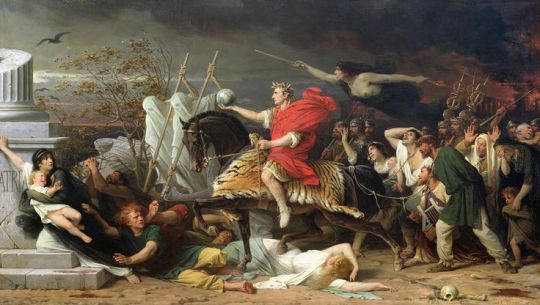

Caesar crossing the Rubicon by Adolphe Yvon; 1875; Painting in the background of Labelle´s office
#romance club#gladiator chronicles#gc appreciation week#rcgcaw#rc appreciation weeks#rc gladiator chronicles#lore
26 notes
·
View notes